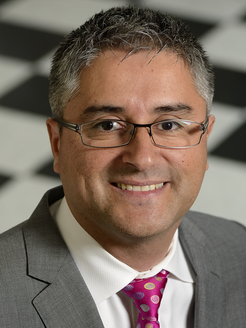René Vidal is the Rachleff and Penn Integrates Knowledge (PIK) University Professor of
Electrical and Systems Engineering &
Radiology and the Director of the
Center for Innovation in Data Engineering and Science (IDEAS) at the University of Pennsylvania. He is also the director of THEORINET, an
NSF-Simons Collaboration on the Mathematical Foundations of Deep Learning, an Amazon Scholar and an Affiliated Chief Scientist at NORCE. His current research focuses on the foundations of deep learning and trustworthy AI and its applications in computer vision and biomedical data science. Dr. Vidal is an ACM Fellow, AIMBE Fellow, IEEE Fellow, IAPR Fellow and Sloan Fellow, and has received numerous awards for his work, including the IEEE Edward J. McCluskey Technical Achievement Award, D’Alembert Faculty Award, J.K. Aggarwal Prize, ONR Young Investigator Award, NSF CAREER Award as well as best paper awards in machine learning, computer vision, controls, and medical robotics.
Professor Vidal received his B.S. degree in Electrical Engineering
(valedictorian) from the
Pontificia
Universidad Catolica de Chile in 1997 and his M.S. and
Ph.D. degrees in Electrical Engineering and Computer Sciences from
the
University of California at
Berkeley in 2000 and 2003, respectively. He was a Research
Fellow at the
National ICT
Australia from September to December of 2003, and an Assistant
and Associate Professor in the
Department of Biomedical
Engineering of
The Johns Hopkins
University from 2004 to 2010 and from 2010 to 2015,
respectively. Dr. Vidal is currently a Full Professor in the
Department of Biomedical Engineering of Johns Hopkins University
with secondary appointments in Computer Science, Electrical and
Computer Engineering, Mechanical Engineering. He is also a faculty
member in the
Center for Imaging
Science, the Institute for Computational Medicine and the
Laboratory for Computational Sensing and Robotics. In 2017, he
became the Innaugural Director of the
Mathematical Institure for Data
Science (MINDS). He has held several visiting faculty
positions at ENS Paris-Saclay, Stanford, INRIA/ENS Paris, the
Catholic University of Chile, Universite Henri Poincare, and the
Australian National University.
Dr. Vidal is co-author of the book ``Generalized Principal
Component Analysis" (2016), co-editor of the book ``Dynamical
Vision" and co-author of over 200 articles in machine learning,
computer vision, biomedical image analysis, hybrid systems,
robotics and signal processing. Dr. Vidal is or has been Associate
Editor in Chief of Computer Vision and Image Understanding,
Associate Editor of Medical Image Analysis, the IEEE Transactions
on Pattern Analysis and Machine Intelligence, the SIAM Journal on
Imaging Sciences, Computer Vision and Image Understanding, and the
Journal of Mathematical Imaging and Vision, and guest editor of
the International Journal on Computer Vision and Signal Processing
Magazine. He is or has been program chair for ICCV 2015, CVPR
2014, WMVC 2009 and PSIVT 2007. He was area chair for AAAI 2016,
NIPS 2015, MICCAI 2013 and 2014, ICCV 2007, 2011, 2013 and 2017,
and CVPR 2005, 2013 and 2017.
Dr. Vidal is recipient of numerous awards, including the 2017 Jean
D'Alembert Faculty Fellowship, the
2012
J.K. Aggarwal Prize for ``outstanding contributions to
generalized principal component analysis (GPCA) and subspace
clustering in computer vision and pattern recognition", the
2012 Best Paper
Award in Medical Robotics and Computer Assisted Interventions
(with Benjamin Bejar and Luca Zappella), the
2011
Best Paper Award Finalist at the Conference on Decision and
Control (with Roberto Tron and Bijan Afsari), the
2009
ONR Young Investigator Award, the
2009
Sloan Research Fellowship, the 2005 NFS CAREER Award and the
2004 Best Paper Award Honorable Mention (with Prof. Yi Ma) at the
European Conference on Computer Vision. He also received the
2004
Sakrison Memorial Prize for "completing an exceptionally
documented piece of research", the
2003
Eli Jury award for "outstanding achievement in the area
of Systems, Communications, Control, or Signal Processing",
the 2002 Student Continuation Award from NASA Ames, the 1998
Marcos Orrego Puelma Award from the Institute of Engineers of
Chile, and the 1997 Award of the School of Engineering of the
Pontificia Universidad Catolica de Chile to the best graduating
student of the school. He is a fellow of the IEEE (2014), fellow
of the IAPR (2016), and a member of the ACM and SIAM.
Complete CV.
If you are interested in joining my lab, please apply directly to the department your are most interested in: Applied Mathematics and Statistics (AMS), Biomedical Engineering (BME), Computer Science, (CS) Electrical and Computer Engineering (ECE), or Mechanical Engineering (ME). Please make sure to mention my name in your application and statement of purpose. Once you have applied, please send me an e-mail with a subject such as 'PhD Application to XXX YYYY', where XXX = AMS, BME, CS, ECE, ME is the department you have applied to, and YYY is the year you plamn to star your PhD. I will not respond emails, but I'll look at applicants that have sent me emails.
